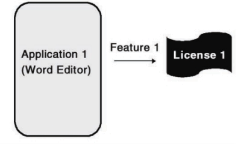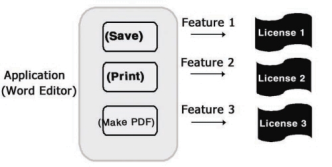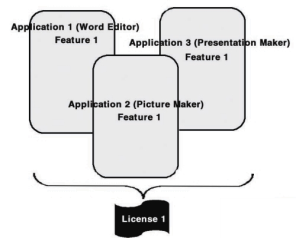Product Functionality (Features)
You can use a license to independently control specific functions of your software application. Perhaps you sell complex pieces of software composed of several autonomous software components and desire the flexibility of having different numbers of licenses for each component. A license can control the complete application or individual functions of your software (for example, Print or Save options). Sentinel RMS uses the term feature to identify the functionality to be licensed. You define feature names while you are licensing your application. See the scenarios below for more clarity.
Here we have taken a few examples of licensing an independent application (Word Editor), its features (Print, Save, and Make PDF), the complete suite of multiple applications (Word Editor, Picture Maker, and Presentation Maker) and so on.
Scenario 1 - At the simplest level, one entire application can be identified using one feature.
Scenario 2 - For more sophisticated licensing, you may use multiple licenses to control multiple capabilities. In this case, you can assign multiple features to an application.
Scenario 3 - You may also use one license to control multiple applications. In this case, you can assign a single feature to multiple applications.

|

Single Application Using Multiple Features |
|
| One License for the Entire Application |
|
|

|
||
| Application Suite Using One Feature |
You need to decide how you want to assign features. Usually, the decision of “what to license” is primarily derived from your product marketing policy. Other factors to consider include: are there key parts of your application that must be available before any other functionality can be used? Are there parts that can be used and purchased separately? Do you want certain parts of the application to be shared between users, while others are reserved for the use of specific users? Do you want certain parts to be available for a limited time, perhaps as a demonstration, while others are permanently available?
The license code generator creates an independent license code for each feature selected, enabling autonomous licensing of each feature. Each feature can specify different options such as node locking, number of concurrent copies, license expiration dates, and so on.
